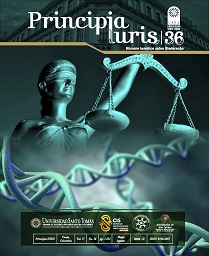Bioderecho, ‘dilema del doble uso’ y libertad de la investigación científica
Contenido principal del artículo
Resumen
Detalles del artículo
Por medio de esta comunicación certifico que el artículo que estoy presentando para posible publicación en la revista institucional impulsada de la Facultad de Derecho de la Universidad Santo Tomás seccional Tunja, Principia Iuris, es de mi entera autoría, siendo sus contenidos producto de mi directa contribución intelectual.
Todos los datos y referencias a publicaciones hechas están debidamente identificados con su respectiva nota bibliográfica y en las citas que se destacan como tal.
Por todo lo anterior, declaro que el material presentado se encuentra conforme a la legislación aplicable en materia de propiedad intelectual, y por lo tanto, me hago responsable de cualquier reclamación relacionada a esta.
En caso de que el artículo presentado sea publicado, manifiesto que cedo plenamente a la Universidad Santo Tomás seccional Tunja los derechos de reproducción del mismo y accedo a las modificaciones que de forma se requieran para adaptarse a la estética de la revista. Como contraprestación de la presente cesión, declaro mi conformidad de recibir (2) ejemplares del número de la revista en que aparezca mi artículo.
Citas
Atlas, Ronald M., and Dando, Malcolm R. "The Dual-use Dilemma for the Life Sciences: Perspectives, Conundrums, and Global Solutions" (Biosecurity and Bioterrorism: Biodefense Strategy, Practice, and Science (2006), 3:4, pp. 276-286).
Browning, Cristopher Origins Evolution of Nazi Jewish Policy, September 1939 - March 1942 (London: Arrow, 2005).
Butler, Declan, and Ledford, Heidi, "U.S. biosecurity board revises stance on mutant-flu studies. Decision comes one day after release of new guidelines for dual-use research" (Nature, 30 March 2012).
Cello, Jeronimo; Paul, Aniko; Wimmer, Eckard, "Chemical synthesis of poliovirus cDNA: generation of infectious virus in the absence of natural template" (Science, 297:5583, 2002, p. 1016-1018).
Chet Tremmel, Joerg (ed.), Handbook of Intergenerational Justice (Cheltenharn, UK; Northarnpton, MA, USA: Edward Elgar 2006).
Cole, David, "Enemy Aliens" (Stanford Law Review, 54, 2002, pp. 953-955).
Philippe, Right. Human Rights Context" (Netherlands Quarterly of Human Rights, 13, 1995, pp. 25-40).
Dando, Malcolm, "Dual-use education for life scientists?" (Ideas for Peace and Security, Disarmament Forum, January 2009, pp. 41-44).
Editorial, "Publishing Risky Research'' (Nature, 485:5, 3 May 2012).
Enserink, Martín, "Dutch appeals court dodges decision on hotly debated H5Nl papers" (Science, 16 July 2015).
Forge, John, ''A Note on the Definition of "Dual Use" (Science of Engineering Ethics, 1:16, 201O, pp. 111-118).
Frosini, Tommaso (ed.), Teoremi e problemi di diritto costituzionale (Milano: Giuffré, 2008).
Gostin, Lawrence O, and Lazzarini, Zita, Human Rights and Public Health in the AIDS Pandemic (New York, USA: Oxford University Press, 1997).
Greenfieldboyce, Nell, "Bird Flu Scientist Has Applied for Permit to Export Research'' (NPR, 24 April 2012).
Herfst, Sander, et al., ''Airborne Transmission of Influenza A/H5Nl Virus Between Ferrets" (Science, 336, 2012, pp. 1533-1541).
Hervey, Tamara K., and McHale, Jean V., Health Law and the European Union (Cambridge, UK: Paperback, 2004).
Imai, Masaki, et al., "Experimental adaptation of an influen:za H5 HA confers respiratory droplet transmission to a reassortant H5 HA/HlNl virus in ferrets" (Nature, 486:7403, 2012, pp. 420-428).
Jackson, Ronald, et al., "Expression of mouse interleukin-4 by a recombinant ectromelia virus suppresses cytolytic lymphocyte responses and overcomes genetic resistance to mousepox" (Journal of Virology, 75, 2001, pp. 1205-1210).
Kuhlau, Frida; Eriksson, Stefan; Evers, Kathinka; and Hoglund, Anna T., "Taking Due Care: Moral Obligations in Dual Use Research'' (Bioethics, 22:9, 2008, pp. 477-487).
Lauren, Paul Gordon, The Evolution of International Human Rights: Visions Seen (Philadelphia: University of Pennsylvania Press, 2003).
Malakoff, David, "Breaking News: NSABB Reverses Position on Flu Papers" (Science Insider, 30 March 2012).
Martín, Brian, "Science: contemporary censorship': In Derek Jones (ed.), Censorship: A World Encyclopedia (Vol. 4, London: Fitzroy Dearborn, 2001, pp. 2167-2170).
Merrills, John E., "Environmental Rights". In Bodansky, Daniel, Brunnée, Jutta, Hey, Ellen (eds.), Oxford Handbook of International Environmental Law (Oxford, UK: Oxford University Press, 2007, pp. 663-680).
Michel, Quentin. "Balancing the freedom of academia and security interests: an impossible objective?", paper presented at the "Non proliferation versus fundamental rights and scientific freedom - a Debating Forum "Science Meets Practice" in Alpbach, 19-20 August 2013.
Miller, Seumas, Selgelid, Michael J., "Ethical and Philosophical Consideration of the Dual-use Dilemma in the Biological Sciences" (Science Engineering Ethics, 13, 2007, pp. 523-580).
Miller, Steven E., and Sagan, Scott D., "Nuclear power without nuclear proliferation?" (Daedalus, Fall 2009, pp. 7-18).
Modugno, Franco, 1«nuovidiritti» nella giurisprudenzacostituzionale (Torino: Giappichelli, 1995).
National Research Council, Biotechnology research in an age of terrorism (Washington, DC: National Acadernies Press, 2004).
Rhodes, Richard, The Making of the Atomic Bomb (New York, USA: Simon & Schuster, 1986).
Riedel, Eibe, The Human Right to Health: Conceptual Foundations (2009,
Romeo Casabona, Carlos María, "Bioderecho y Bioética': In Carlos María Romeo Casabona (ed.), Enciclopedia de Bioderecho y Bioética (Granada: Editorial Comares, 2011, pp. 187-205).
Salvi, Maurizio, "What Responsibility for Science" (Law and the Human Genome Review, 17, July-December 2002, pp. 125- 134).
Santosuosso, Amedeo; Sellaroli, Valentina; Fabio, Elisabetta, "What constitutional protection for freedom of scientific research?" (Joumal of Medical Ethics, 33:6, 2007, p. 342-344).
Schmidt, Markus, and Giersch, Gregor, "DNA Synthesis and Security". In Campbell, Marissa (ed.), DNA Microarrays , Synthesis and Synthetic DNA (New York, USA: Nova Publishers, 2011, pp. 285-300).
Schweber, Silvan S., In the Shadow of the Bomb: Bethe, Oppenheimer, and the Moral Responsibility of the Scientist (Princeton, N.J.: Princeton University Press, 2000).
Selgelid, Michael J., ''A Tale of Two Studies. Ethics, Bioterrorism, and the Censorship of Science" (Hastings Center Report, 37:3, 2007, pp. 35- 43).
Trevan, Tim. "Do not censor science in the name of biosecurity" (Nature, 486:7403, 2012, p. 295).
Tumpey, Terrence M., et al., "Characterization of the reconstructed 1918 Spanish influenza pandemic virus': (Science, 310:5745, 2005, pp. 77-80).
UK Parliamentary Offi.ce of Science and Technology, The dual-use dilemma (London: Parliamentary Offi.ce, n. 340, 2009).
Valdés, Erick. "Towards a New Conception of Biolaw. In, Valdés, E. & Lecaros, J.A. Biolaw and Policy in the Twenty-First Century: Building Answers for New Questions. (Switzerland: Springer, 2019, pp. 41-68).

